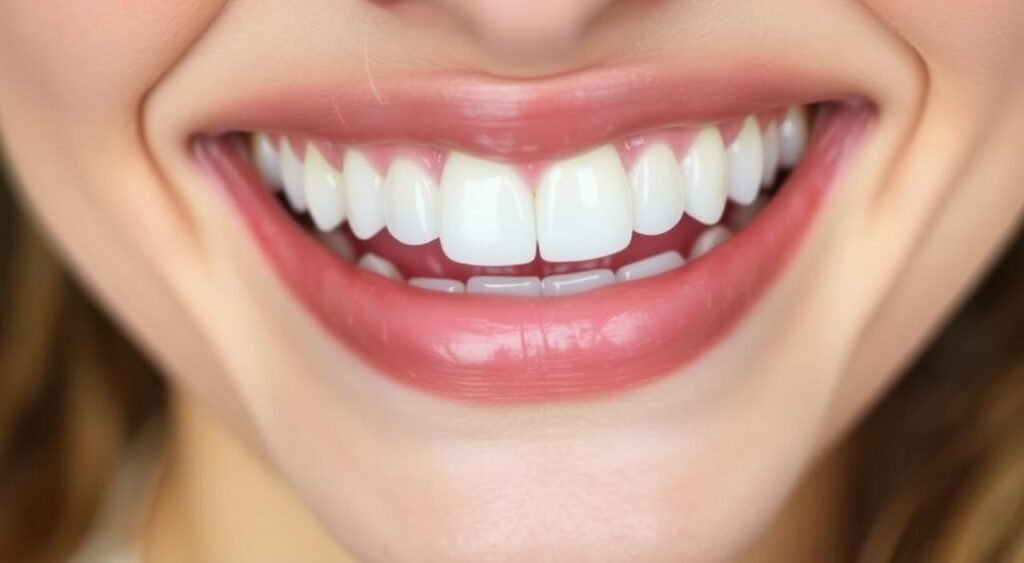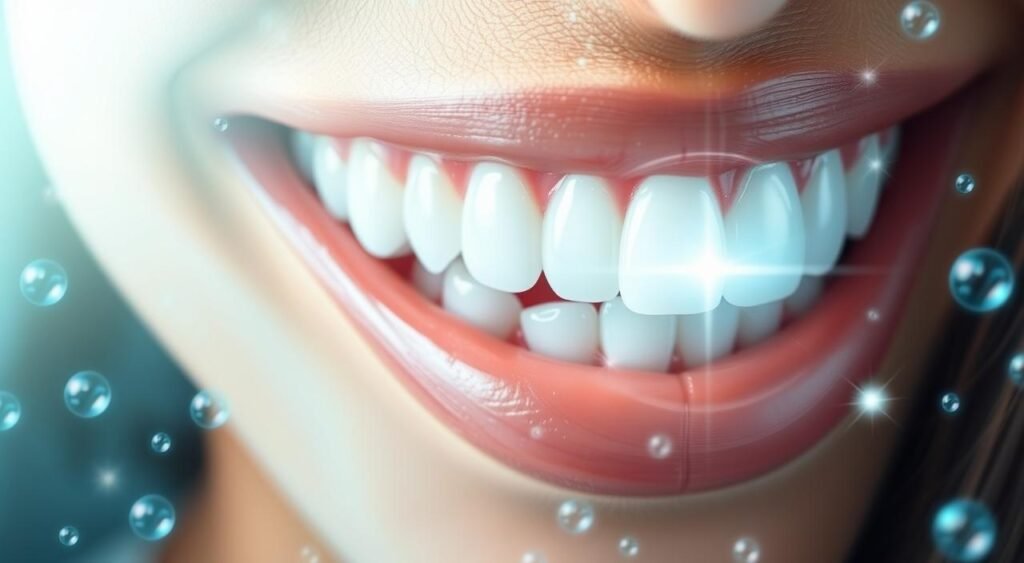Ever thought about if fluoride in toothpaste brightens your smile? This question has sparked debates everywhere. Standing in front of the mirror, you might wonder: does fluoride whiten teeth, or is it just a myth?
We all want a dazzling smile like Hollywood stars. But before switching to new whitening products, let’s find out the truth. Does fluoride turn teeth yellow, or could it actually make them whiter? Let’s explore dental chemistry to find out.
We’ll look into how fluoride changes your teeth’s color. You’ll learn its effect on enamel and if fluoride whitening is real or just marketing. You’ll also find out how to get that bright smile everyone wants. Get ready to learn something that will impress your dentist!
- Understanding Fluoride: What It Is and How It Works
- The Truth About Teeth Whitening
- Does Fluoride Whiten Teeth?
- How Fluoride Strengthens Tooth Enamel
- Fluoride Toothpaste: Whitening Claims and Reality
- Potential Side Effects of Fluoride on Tooth Color
- Effective Teeth Whitening Methods: With and Without Fluoride
- Conclusion
Understanding Fluoride: What It Is and How It Works
Fluoride is crucial for your teeth. It’s found in water and many foods. Let’s explore what fluoride is and how it benefits your teeth.
The Chemical Composition of Fluoride
Fluoride is a form of fluorine. It bonds well with other elements, making it great for protecting teeth. When it mixes with your tooth enamel, it makes your teeth stronger against decay.
Fluoride’s Role in Dental Health
Does fluoride help teeth? Yes, it does! It protects your teeth in two main ways:
- It strengthens developing teeth in children
- It helps rebuild weakened tooth enamel in adults
Fluoride also makes it harder for bacteria to produce acid that harms your teeth.
Sources of Fluoride in Daily Life
You can find fluoride in many everyday items:
| Source | Type of Fluoride |
|---|---|
| Tap water | Sodium fluoride |
| Toothpaste | Sodium fluoride or stannous fluoride |
| Mouthwash | Sodium fluoride |
Many people use fluoride teeth whitening toothpaste daily. While fluoride doesn’t whiten teeth directly, it keeps them healthy and strong. This can make them look better overall.
The Truth About Teeth Whitening
Teeth whitening is a popular trend for a brighter smile. Many wonder if fluoride whitens teeth or if there are better methods. The truth is, fluoride is important for dental health but not for whitening.
To understand how to whiten teeth, it’s key to know what causes discoloration. Stains from coffee, tea, and tobacco are common. Age and certain medications can also change tooth color. Professional treatments often give the best results, using stronger agents than at-home kits.
For those wondering if fluoride makes your teeth white, the answer is no. Fluoride strengthens enamel, which helps prevent staining. This indirect benefit makes teeth look cleaner but doesn’t whiten them.
- Professional whitening: Fastest results, but more expensive
- At-home whitening strips: Convenient, gradual improvement
- Whitening toothpaste: Mild effect, best for maintenance
- Natural methods: Gentle, slow results (e.g., baking soda, oil pulling)
When choosing a whitening method, think about your dental health, budget, and time. Remember, good oral hygiene is key to a bright smile, no matter the whitening method.

Does Fluoride Whiten Teeth?
Many people wonder if fluoride whitens teeth. The truth is, fluoride doesn’t directly whiten your teeth. Its main job is to strengthen tooth enamel and prevent decay. Let’s look at how fluoride affects tooth color and clear up some common myths.
Direct Effects on Tooth Color
Fluoride itself doesn’t change the color of your teeth. It doesn’t bleach or whiten enamel. Too much fluoride when teeth are developing can cause dental fluorosis. This can lead to white spots or streaks on teeth.
Indirect Benefits for Tooth Appearance
Fluoride doesn’t whiten teeth directly, but it can help your smile look brighter indirectly. By making enamel stronger, fluoride helps teeth resist stains and decay. This keeps your teeth looking cleaner and brighter over time.
Common Misconceptions
Some think fluoride makes teeth yellow or stains them. But this is not true for normal fluoride use. Staining happens only with too much fluoride, which is rare with proper use of fluoride products.
| Belief | Reality |
|---|---|
| Fluoride whitens teeth | Fluoride doesn’t directly whiten teeth |
| Fluoride yellows teeth | Normal fluoride use doesn’t yellow teeth |
| Fluoride stains teeth | Staining only occurs with excessive fluoride intake |
Knowing how fluoride really works on your teeth can help you choose better for your oral care. It may not whiten your teeth, but fluoride is key for keeping your teeth healthy.
How Fluoride Strengthens Tooth Enamel
Fluoride is key in protecting your teeth. It makes tooth enamel stronger, helping it resist decay. But fluoride does more than that. Let’s see how it keeps your teeth healthy.
Fluoride in toothpaste or mouthwash bonds with your enamel. This process, called remineralization, fixes weak spots. It makes your teeth stronger and less likely to decay.
Fluoride also battles harmful bacteria in your mouth. Does fluoride kill bacteria? Yes, it does. By reducing bacteria, fluoride lowers cavity and gum disease risks.
Some ask if sodium fluoride 5000 ppm whitens teeth. It’s not a whitening agent, but high-concentration fluoride boosts tooth health. This can make your smile brighter.
| Fluoride Benefit | How It Works |
|---|---|
| Strengthens Enamel | Bonds with tooth surface, creating a protective layer |
| Fights Bacteria | Reduces bacterial growth in the mouth |
| Prevents Decay | Makes teeth more resistant to acid attacks |
| Supports Remineralization | Helps repair early stages of tooth decay |
Understanding fluoride’s role helps you choose better dental care. Regular fluoride use greatly improves your oral health. It keeps your smile strong for years.
Fluoride Toothpaste: Whitening Claims and Reality
Fluoride toothpaste is a key part of many dental routines. But does it really whiten teeth? Let’s look into the truth behind these claims and how fluoride works with other whitening agents.
Analyzing Popular Fluoride Toothpaste Brands
Many toothpaste brands say their products whiten teeth with fluoride. They claim fluoride strengthens enamel, which can make teeth look better. Here’s a look at some popular brands:
| Brand | Fluoride Content | Whitening Claim | Additional Whitening Agents |
|---|---|---|---|
| Colgate Total Whitening | 0.24% Sodium Fluoride | Whitens teeth in 14 days | Silica abrasives |
| Crest 3D White | 0.243% Sodium Fluoride | Removes up to 80% of surface stains | Hydrogen peroxide |
| Sensodyne Pronamel Gentle Whitening | 0.15% Sodium Fluoride | Gently whitens while strengthening enamel | Calcium carbonate |
The Science Behind Whitening Toothpastes
Fluoride itself doesn’t whiten teeth directly. But it’s key for oral health. It makes enamel stronger, helping teeth resist stains and decay. This helps teeth look brighter.
Combining Fluoride with Other Whitening Agents
To boost whitening, brands mix fluoride with other stuff. This might include mild abrasives, hydrogen peroxide, or enzymes. This mix offers fluoride’s health benefits and cosmetic whitening.
In short, fluoride toothpaste doesn’t directly whiten teeth. But it’s vital for oral health. For real whitening, look for toothpastes with fluoride and specific whitening ingredients.
Potential Side Effects of Fluoride on Tooth Color
Fluoride is good for your teeth, but some worry it might change their color. You might ask, does fluoride make teeth yellow? The answer is no, fluoride itself doesn’t make teeth yellow. In fact, there are fluoride products that help whiten teeth.
But, too much fluoride can cause dental fluorosis, especially in kids. This can lead to white spots or brown stains on teeth. This happens when kids get too much fluoride when their teeth are still growing, not from using fluoride products normally.
So, does fluoride stain teeth? Not directly. Stains usually come from diet, smoking, or not brushing well. Fluoride can actually help prevent stains by making enamel stronger, so teeth are less likely to discolor.
| Fluoride Effect | Impact on Tooth Color | Prevention |
|---|---|---|
| Normal Use | No discoloration | Follow dentist recommendations |
| Overexposure | Possible white spots or brown stains | Monitor fluoride intake in children |
| Enamel Strengthening | Helps resist stains | Use fluoride toothpaste daily |
To keep your teeth white and enjoy fluoride’s benefits, use fluoride products as directed. Also, brush well and visit your dentist regularly. This will help keep your smile bright and healthy.

Effective Teeth Whitening Methods: With and Without Fluoride
Wondering how to whiten teeth? You have many options, from professional treatments to at-home kits. Let’s look at these methods to see which might be best for you.
Professional Whitening Treatments
Dentists offer strong whitening treatments that can really brighten your smile. These treatments use high-concentration peroxide gels and special lights or lasers. They are effective but can be expensive and might cause sensitivity.
At-Home Whitening Options
Many people choose at-home kits for their convenience and cost. These include strips, trays, and pens. Some of these kits have fluoride for extra protection. Keep in mind that results may take longer and can vary compared to professional treatments.
Natural Teeth Whitening Alternatives
Looking for natural options? Oil pulling, baking soda pastes, and hydrogen peroxide rinses are popular. They are gentler but may take longer to show results.
| Whitening Method | Effectiveness | Cost | Duration |
|---|---|---|---|
| Professional Treatment | High | $$$ | 1-2 hours |
| At-Home Kits | Moderate | $$ | 1-2 weeks |
| Natural Alternatives | Low to Moderate | $ | Several weeks |
When picking a whitening method, think about your budget, time, and sensitivity. Talk to your dentist to find the best option for your teeth.
Conclusion
Fluoride is key for dental health, but it doesn’t whiten teeth. The answer to “does fluoride whiten teeth” is clear: no. Its main role is to strengthen teeth and prevent decay, not to change their color.
Even so, fluoride can help keep your smile bright. It protects teeth from stains and decay. Using fluoride toothpaste regularly can make your teeth look cleaner and healthier.
If you want a whiter smile, using fluoride with other whitening methods is best. You can try professional treatments, at-home kits, or natural options. Remember, fluoride keeps your teeth strong and healthy, which is important for a beautiful smile.
In summary, fluoride is a hero for your teeth, but not for whitening. It’s vital for your oral health, so keep using it every day. For a bright smile, combine good oral care with safe whitening methods. Your teeth will stay healthy and shine for years.
FAQ – Fluoride and Teeth Whitening
Does fluoride whiten teeth?
Fluoride itself doesn’t directly whiten teeth. But it can help make your smile brighter. It strengthens enamel and prevents decay, which can cause teeth to look dull.
Does fluoride make teeth yellow or stain them?
No, fluoride doesn’t make teeth yellow or stain them when used right. It actually helps keep teeth white by stopping decay and erosion.
How does fluoride help teeth?
Fluoride makes tooth enamel stronger. This makes teeth more resistant to acid attacks from plaque bacteria. It helps prevent cavities and erosion, which can make teeth look dull.
Do fluoride toothpastes whiten teeth?
Most fluoride toothpastes aren’t made for whitening. But some brands add whitening agents. These help remove stains and make teeth brighter.
Does sodium fluoride 5000 ppm whiten teeth?
Sodium fluoride at 5000 ppm is a strong fluoride treatment. It doesn’t directly whiten teeth. But it can make teeth brighter by strengthening enamel.
Does fluoride kill bacteria in the mouth?
Yes, fluoride kills harmful bacteria in the mouth. This helps prevent tooth decay and discoloration.
How can I whiten my teeth with fluoride?
Fluoride itself doesn’t whiten teeth. But using fluoride toothpaste and mouthwash can help. They prevent decay and erosion, which can make teeth look dull. For the best results, use fluoride products with other whitening methods.









1 Comment
Pingback: Pregnancy Safe Teeth Whitening: Tips for Moms-to-Be